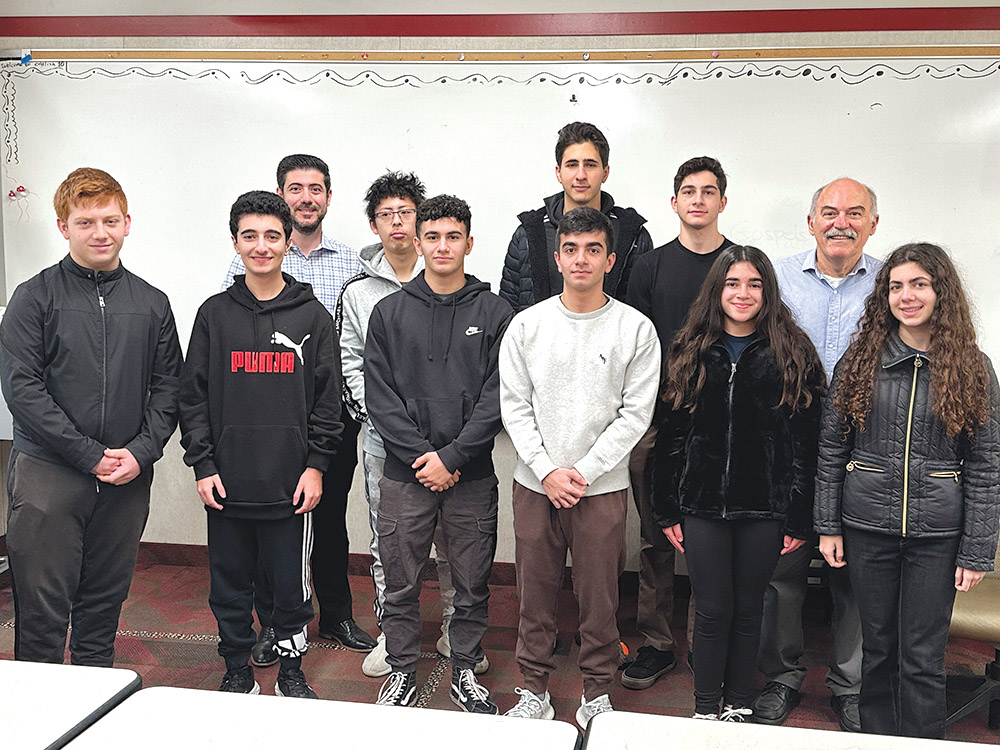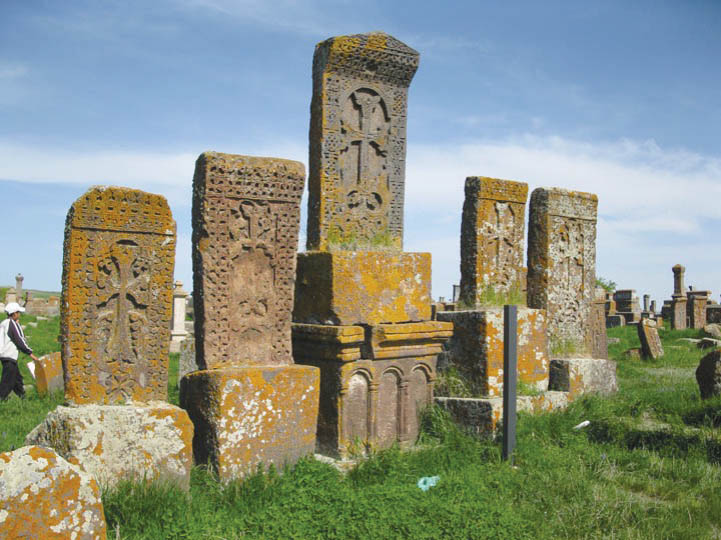
Photo: ASP Archive
Staff Report
Students at University High School on the Fresno State campus had the opportunity to enroll in a special Armenian Studies course as part of their Winter Intersession, from January 3-12, 2024. Taught by Fresno State Armenian Studies faculty Prof. Barlow Der Mugrdechian and Dr. Hagop Ohanessian, the students explored various aspects of Armenian culture including Armenian art, literature, and history.
Ten students: Sarkis Adjinian, Alen Aghakhanyan, Sarine Der Simonian, Edgar Gasparyan, Abraham Hayrapetyan, Gagik Khachatryan, Hrayr Sadoian, Alina Tateosian, Robert Volkov, and Nathan Yu, participated in the intensive course, which took place from 8:00-11:00AM each day of the intersession.
Prof. Der Mugrdechian introduced students to the arts of Armenia, including manuscript painting, architecture, and the study of Armenian khatchkars (stone-crosses). During each of the sessions, students were encouraged to draw their own examples of Armenian art. Prof. Der Mugrdechian distributed drawing paper and colored pencils and asked students to produce their own interpretations of the various art forms studied.
The course began with an overview of the modern country of Armenia. Prof. Der Mugrdechian presented a power-point high-lighting the historic sites in Armenia and the natural beauty of the countryside. He explained that art is a part of everyday life in Armenia, as there are numerous museums and churches in the country.
The history of Armenian manuscript production was the next topic, with emphasis on the miniature paintings. Prof. Der Mugrdechian gave an overview of how Armenian manuscript painting developed and the major themes in the art. Students enjoyed learning about the beauty of the paintings and about artists such as Toros Roslin.
Armenian architecture is one of the main forms of Armenian art and students learned about how Armenian Christian architecture developed over the centuries. Armenian church architecture can be organized around the styles of churches, from the simpler single-hall style of church to the more complex, niche-buttressed square and Hripsime style. Examples of each of these styles was studied in the class.

Photo: Barlow Der Mugrdechian
Armenian khatchkars (stone-crosses) represent a unique form of Armenian art. Thousands of khatchkars have been produced over the centuries, especially in the period from the 9th to the 13th centuries. Students learned about the major motifs in khatchkar art before drawing their own khatchkars.
“It was a pleasure to teach these high-school students about Armenian culture,” said Prof. Der Mugrdechian. “I hope to see some of the students enroll at Fresno State and to take Armenian Studies courses.”
Dr. Hagop Ohanessian also had the privilege to participate in Winter Intersession enrichment program. His lessons focused on highlighting the importance of Armenian literature as a form of preserving and expressing identity. He presented and highlighted prominent modern Western and Eastern Armenian writers such as Vahan Tekeyan, Daniel Varoujan, Krikor Zohrab, and Hovhaness Toumanian.
Students learned the impact that Western European literary trends, such as Romantism and Realism, played in shaping modern Armenian literature.
For example, students were asked to read notable poems and short stories by each author in class. Students read Tekeyan’s famous poems “The Armenian Language” and the “The Armenian Church.” They learned that Tekeyan used romantic language and metaphors to describe the value in language and faith as components in preserving identity.
In his poem “The Armenian Church,” Tekeyan writes that “The Armenian Church is the birthplace of my soul … the mighty fortress of my forefather’s faith….”
Students had the opportunity to engage not only with Dr. Ohanessian, but with fellow classmates on the importance of maintaining Armenian identity through the many examples read. Students learned the way in which Krikor Zohrab utilized “Realism” in his short stories to express the social, political, and economic challenges Armenians faced on the eve of the Genocide. For example, students read such notable stories as “The Black Bag” and “Furtuna,” highlighting various societal challenges such as poverty, isolation, addiction, and the attachment to material goods.
Dr. Ohanessian also introduced students to Armenian-American writers such as William Saroyan, Leon Surmelian, and Peter Najarian as a way to discuss and to better understand the experiences of early Armenian immigrants to the United States. Students read and discussed the short stories “The Armenian Mouse,” “Madness in a Family,” and “America in My Blood.”
Dr. Ohanessian also asked students to present on their own family stories of immigration, to better understand their own stories and the importance of passing it on to future generations.
Dr. Ohanessian completed the course by discussing various aspects of the Armenian Genocide and the class held a fruitful discussion of the Armenian com-munity of Fresno and the central San Joaquin Valley.
It was a wonderful experience for Dr. Ohanessian and the students who participated.
Dr. Ohanessian recounted the high level of engagement, enthusiasm, and curiosity of each student and enjoyed each day he spent time with them. He is grateful to UHS’s administration for the opportunity that they provided not only for the students, but also for the faculty.
 Hye Sharzhoom Armenian Action
Hye Sharzhoom Armenian Action